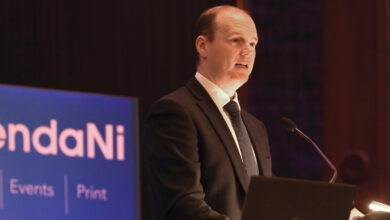Reconciliation & remembrance
 The 70th anniversary of the Battle of the Atlantic was marked in a tolerant way in another sign of a shared future in Derry.
The 70th anniversary of the Battle of the Atlantic was marked in a tolerant way in another sign of a shared future in Derry.
A commemoration of the Second World War’s longest campaign has recognised Derry’s strategic importance and been viewed as another step forward for the city.
The Battle of the Atlantic lasted from the first day of the Second World War to the fall of Germany. Its turning point, in May 1943, is marked by an annual series of events around the UK.
Derry served as the main anti-submarine warfare base for the British, Canadian and US navies. The city hosted 140 ships alongside refuelling facilities at Lisahally, a training base at Ebrington Barracks and a repair yard at Fort George. Swordfish aircraft from nearby airfields flew out to join carriers escorting convoys across the ocean. The city shared in the Allied victory when several U-boats surrendered at Lisahally in May 1945.
Royal Naval Association Chairman Robert Buchanan explained afterwards that the event involved four years of planning. “The weekend was a culmination of that hard work and it was well worth it, especially as it meant so much to the veterans,” he said.
Some of the visiting veterans from Canada were aged in their late 80s and early 90s. The weekend involved a poignant commemoration for the crew of the troop-carrier HMS Laurentic, which was lost off Donegal in 1940.
Speaking to agendaNi, a Royal Navy spokesman explained that winning the battle was “vital, not just for the UK and the British Isles, but for the whole Allied war effort.” It ensured the continued transport of soldiers, food, fuel and armaments across the Atlantic.
The Allies had mainly overcome the U-boat threat by 1942 but a change of tactics in 1943 put submarines back “in the ascendancy”. That was countered by extended air cover from the UK and Iceland.
Forty thousand naval personnel were stationed in the city in 1943 and 1944, more than the city’s population at the time. The visiting forces, the spokesman said, were “welcomed and supported ably and efficiently by the people of Derry who were doing their contribution in the fight against Axis oppression, and it cannot be understated.”
Prince Michael of Kent was guest of honour at the commemorations and unveiled an official memorial – the International Sailor Statue – at Ebrington Square. The statue was taken from the mould of a similar statue in Halifax, Nova Scotia, but has no mention of any specific nation. Instead, it is designed to remember all who died in the battle.
In total, around 100,000 lives were lost in the Atlantic between 1939 and 1945. A commemoration service took place in St Columb’s Cathedral and was followed by wreath-laying ceremonies at the Cenotaph and on the River Foyle.
Preparing for the event was a “labour of love” for DUP MLA William Hay. For him, the hospitality shown to Prince Michael was “a sign that this city has moved on and a great indicator that we are perhaps moving towards a real shared future.”
“At a commemoration like this, it is important not just to talk about what was won but also to think about all who were lost,” Foyle MP Mark Durkan said. “It is also timely to reflect on the transformation of relationships in Europe which have made such wasteful conflict unthinkable for subsequent generatio





